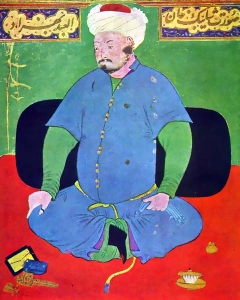From Mongols to Uzbeks and Kazakhs
Uzbeks and Kazaks are the dominant peoples of today’s Central Asia, but they did not arrive in the region until the very end of the 15th century. By then the Golden Horde had fractured into several rival sub-groups, and the future Uzbeks and Kazaks came from the same loose confederation of Turko-Mongol tribes that lived north and a little east of the Caspian Sea.
Abulghazi Bahadur Khan, 1603 - 1663
“The son of Arab Muhammad-Khan, Abulghazi Bahadur Khan, the Genghisid, the Khwarazmian, says: Historians have written, both in Turki and Persian, the history of the ancestors and descendants of Genghis Khan who had reigned in different countries... However, both because of negligence on the part of our ancestors and of the ignorance of the people of Khwarazm, no one has written a history of the rulers of our family...This is why I have decided to do it myself” (Soucek, p. 185). Note: Four hundred years after Chingis Khan had died, this ruler identified himself 1) genealogically, as a son and then as a Chingisid, and 2) geographically.
Abulkhayr and the Shibanids
The leader who began raids into Transoxiana (Abulkhayr, 1412–1468), claimed political legitimacy on the basis of his descent from Chingis Khan’s son Jochi, via Jochi’s fifth son (out of 13), Shiban. The exact son was very important, since lineage was key to the leadership’s identity as well as legitimacy. Descent from Shiban gave Abulkhayr control of a separate territory to the east of those claimed by other former Golden Horde factions. Accordingly, contemporary Muslim historians as well as modern scholars refer to the tribe as the Shibanids or, in some accounts, Shaybanids. Another name for them was becoming common in the fifteenth century: Uzbek or Özbeg. The origins of this name are murky, but their own tradition associated the name with Uzbek Khan of the Golden Horde (1313–1341) who converted the entire horde to Islam.
This tradition also illustrates the flexible nature of nomadic identities, since Uzbek was a descendant of another son of Jochi, Berke, and of a different ruling dynasty than Shiban’s. The contradiction bothered no one— except modern historians, with our love of fixed categories and rules. What was important was to fix and explain their location in the larger Islamic world. As historian Robert McChesney says, “Genealogy may be validated by a historical narrative, or chronology, which sets present realities in the context of a reified past. But it is less important that genealogy be authenticated by independent means than that it match people’s ideas of what is right and true. Biography and chronology supplement genealogy by linking the power of story-telling to the skeleton of mere kinship. All are important building blocks in the evolution of a sense of political community [McChesney, p. 120].
The Kazakh-Uzbek split
The Shibanid tribes lived just east of the Urals and north of Timurid Transoxiana, in an area called the Desht-i Qipchaq, or Kipchak Steppe. In 1428 they elected Abulkhayr as their khan. Under Abulkhayr’s aggressive leadership, they pushed south, occupying Khwarezm in 1431 . Abulkhayr and the Uzbeks continued to raid as far south as Samarkand and Herat until 1456, when a new group of Mongols invaded from the western part of the original Mongol homeland. This group, known variously as the Oirats or Kalmyks or Zunghars, inflicted significant damage on the Uzbeks and other Turkic tribes; ultimately the Kalmyks converted to Buddhism and settled along the southern Volga. For steppe warriors like Abulkhayr, one thing could trump genealogy in establishing or destroying political legitimacy: success or failure in battle. Defeat by the Kalmyks drove away many of Abulkhayr’s fighters and their families. The leaders of this rebellion, Janibek and Girey, led their tribes east in 1459 to the Lake Balkhash area. They were called or called themselves “freebooters” (one meaning of the Turkic word Kazak), and they established an independent horde called Uzbek-Kazaks and, by the mid-16th century, just Kazaks. In another hundred years or so the Kazaks themselves would split into three hordes, the “Lesser,” “Middle,” and “Greater,” each with a distinct territory.
Other Turko-Mongol descent groups
Abulkhayr’s grandson Muhammad Shaybani Khan (1451–1510) completed the Uzbek conquest of Transoxiana, but that’s not the end of the “rise of the Uzbeks” story. Shaybani’s direct descendants (the Shaybanids) ruled in Bukhara until 1599 and were succeeded by other Turko-Mongol tribes from other genealogical lines, the Janids or Ashtarkhanids (1599–1747), and the Manghits (1756–1920). The Manghits, however, could not claim to be part of the Golden Kin, and so their rulers were called emirs rather than khans. Other Uzbek tribal confederations from the Desht-i Qipchaq took over the western region of Khorezm in 1511 (referred to from the 17th century as the Khanate of Khiva), setting up independent dynasties: the Yadigarids or Arabshahids (who ruled until around 1770), and the Qongrats (late 18th century to 1920). Since the Qongrats too were not Chingisid, they ruled behind puppet khans before simply taking the title of “khan” for themselves in 1806. In the early 18th century another Uzbek tribe, the Ming, began to establish its control of the Ferghana Valley. Still other Uzbek tribes did not create their own kingdoms, but lived in Transoxiana under the rule of one of the aforementioned dynasties.
The Chaghatay khans of Mogholistan (encompassing roughly today’s Kyrgyzstan, southeast Kazakhstan, and most of today’s Xinjiang Province) were converted to Islam in the 14th century by Naqshbandi Sufi sheikhs. Unlike their Shibanid cousins, however, they did not evolve into new conquering dynasties. Instead, the Chaghatay khans were usurped and used as puppet rulers in the 1340s by a non-Chingisid line of Mongol chiefs, the Dughlat dynasty. Within 200 years the Chaghatids disappeared, replaced by powerful sheikhs (the khojas or khwajas), resurgent Turkic pastoralists (the Kyrgyz and Uyghurs), and the non-Chingisid Mongol Oirats/Zunghars.

